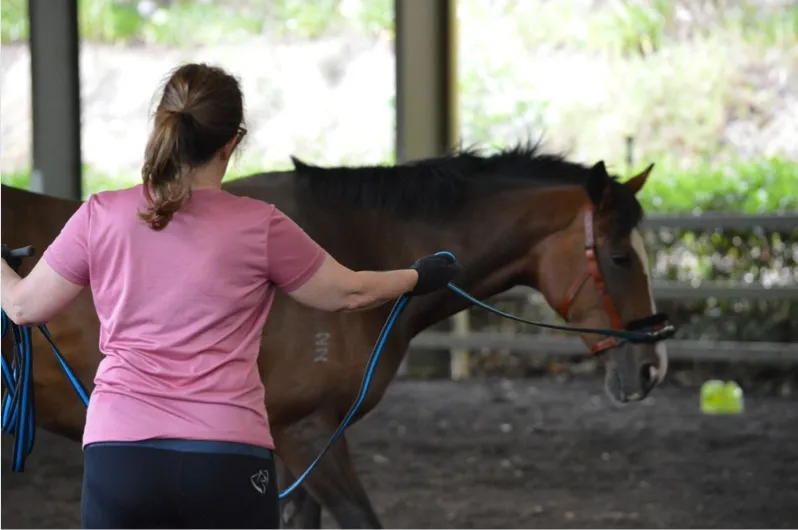The Importance of Lunging in Horse Training: A Classical Dressage Perspective
Lunging is an essential component of Classical Dressage training, playing a pivotal role in developing a horse's balance, flexibility, and overall performance. When executed correctly, lunging not only enhances the horse's physical conditioning but also strengthens the bond between horse and rider. In this blog, we'll delve into the significance of lunging from a Classical Dressage perspective, focusing on techniques such as using a cavesson or serreta, the importance of equal training on both sides, and the benefits of lunging at various gaits.
What is Lunging?
Lunging involves directing a horse in a circle around the handler, typically performed in an arena. This exercise is carried out using a lunge line attached to a cavesson or serreta, which is a specialized headgear designed to give the handler better control of the correct head position and communication with the horse. Additionally, the horse should be equipped with protective boots to safeguard against potential injuries from repeated circular movement.

The Role of Lunging in Classical Dressage
Classical Dressage emphasizes the development of a horse's natural abilities through a systematic approach to training.
Lunging aligns with these principles by:
Enhancing Longitudinal and Lateral Balance: Lunging helps in achieving the horse's longitudinal balance (the balance between forehand and hindquarters) and lateral balance (the balance between left and right sides). Working on both types of balance is crucial for a horse’s overall performance and comfort.
Improving Flexibility and Strength: By moving in circles at various gaits, the horse develops flexibility and strength in the muscles required for advanced movements. This helps in reducing stiffness and enhancing the horse's range of motion.
Establishing Rhythm and Suppleness: Lunging is an effective way to establish a regular rhythm and increase the horse's suppleness. This rhythmic consistency is foundational for more complex dressage movements.

Preparing for a Lunging Session
Before starting a lunging session, it is vital to ensure that both the horse and equipment are prepared. Here’s a checklist for a successful lunging session:
Equipment Check: Ensure the cavesson or sereta is properly fitted. The cavesson should be snug but not restrictive, allowing for clear communication. The horse should wear boots to protect its legs from strain and injury.
Arena Setup: Choose a safe, enclosed area such as a riding arena. Mark out a 10-12 metre distance to help guide accurate lunging circles.
Warm-Up: Begin with a gentle warm-up at the walk to get the horse’s muscles relaxed and ready for more intensive work.
LUNGING TECHNIQUE: STEP BY STEP
1. Starting at the Walk:
Begin by asking the horse to move at a relaxed walk. This allows the horse to adjust to the circular movement and warms up the muscles.
Maintain a consistent circle and ensure the horse is responding to gentle cues from the lunge line. The goal is to establish a steady rhythm and get the horse used to the lunge line and whip.
2. Transition to Trot:
After a sufficient warm-up, gradually ask the horse to transition to a trot. This is where the horse’s fitness and suppleness are tested.
Focus on maintaining a steady trot with a consistent pace. Observe how the horse’s body adjusts to the increased speed and make adjustments as necessary.
3. Introducing the Canter:
Once the horse is comfortable at the trot, introduce the canter. The canter requires more balance and engagement from the horse’s hindquarters.
Pay close attention to the horse’s balance and rhythm. The goal is to ensure the horse remains engaged and balanced throughout the canter.
4. Returning to Trot and Walk:
After a lap at the canter, bring the horse back to a trot to allow it to recover and assess its responsiveness and balance.
Finally, end the session with a walk to cool down. This helps relax the muscles and reduce the risk of injury.
5. Changing Direction:
After completing the lunging process in one direction, change direction to ensure balanced training. This step is crucial as it prevents the horse from developing imbalances or stiffness on one side.

BENEFITS OF BALANCED LUNGING
1. Preventing Imbalances:
Training the horse equally on both sides helps in preventing asymmetries and uneven muscle development. This is vital for the horse's long-term health, soundness and performance.
2. Enhancing Performance:
Consistent lunging improves the horse’s performance in other training sessions. The strength and suppleness gained through lunging translate into better movements under saddle.
3. Strengthening Bond:
Lunging fosters a strong bond between horse and handler. Clear communication and mutual trust are developed as the horse learns to respond to cues effectively.
4. Increasing Arena Exposure:
Lunging exposes the horse to the entire arena, helping it become accustomed to different environments and conditions. This exposure is beneficial for building confidence and reducing spookiness.

CONCLUSION
Lunging is a fundamental aspect of Classical Dressage training, offering numerous benefits for the horse’s physical and mental development. By employing techniques such as using a cavesson or serreta, ensuring balanced training on both sides, and working through various gaits, trainers can enhance their horse’s performance and overall well-being.
Incorporating lunging into your training regimen not only improves the horse's balance, flexibility, and strength but also builds a deeper connection between horse and handler. As you continue to refine your lunging techniques and adhere to classical dressage principles, you'll see significant improvements in your horse’s performance and overall demeanour.
For those new to lunging or looking to refine their technique, consider working with a knowledgeable instructor to ensure that both you and your horse are getting the most out of each session.
Happy lunging!
